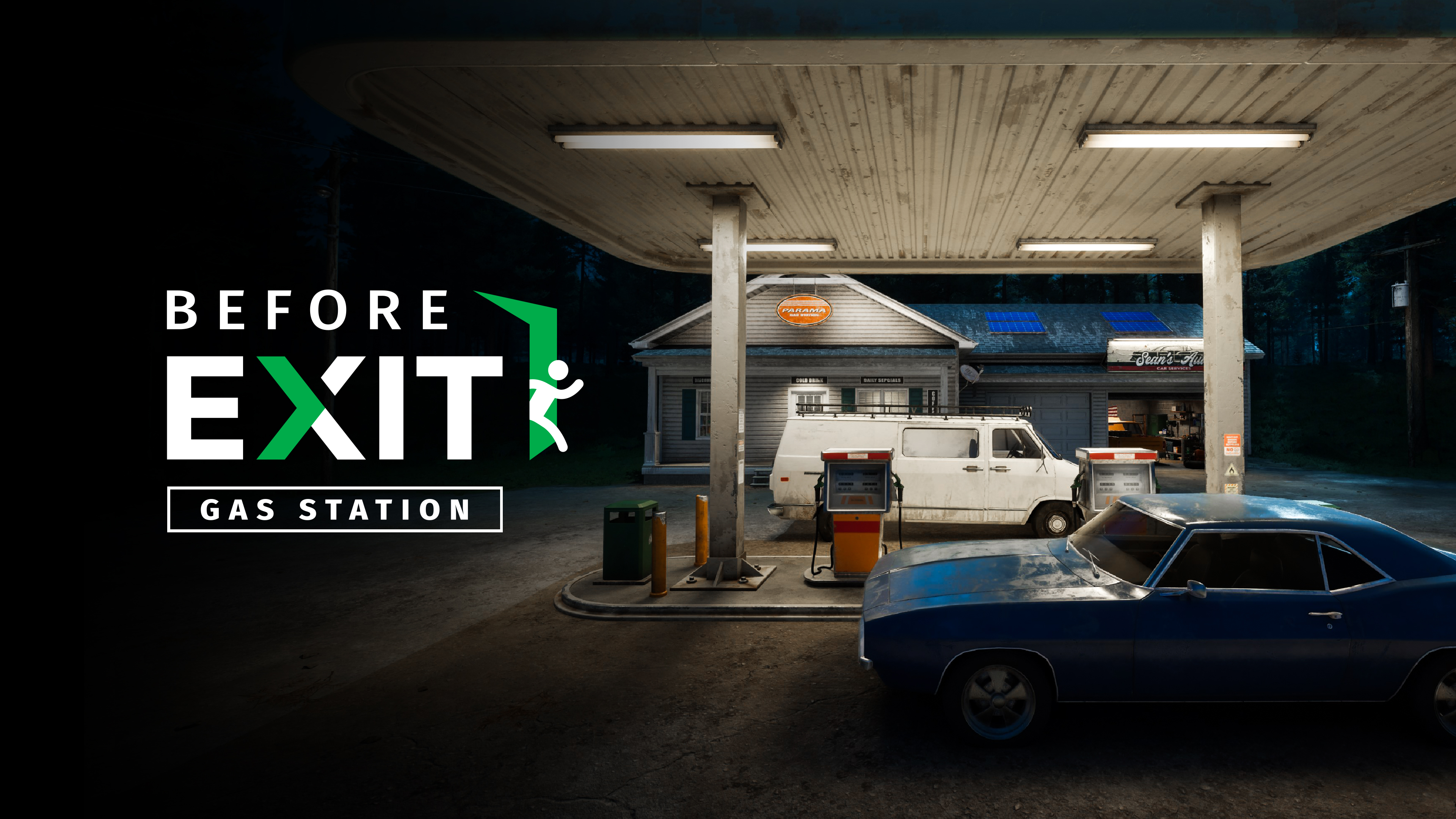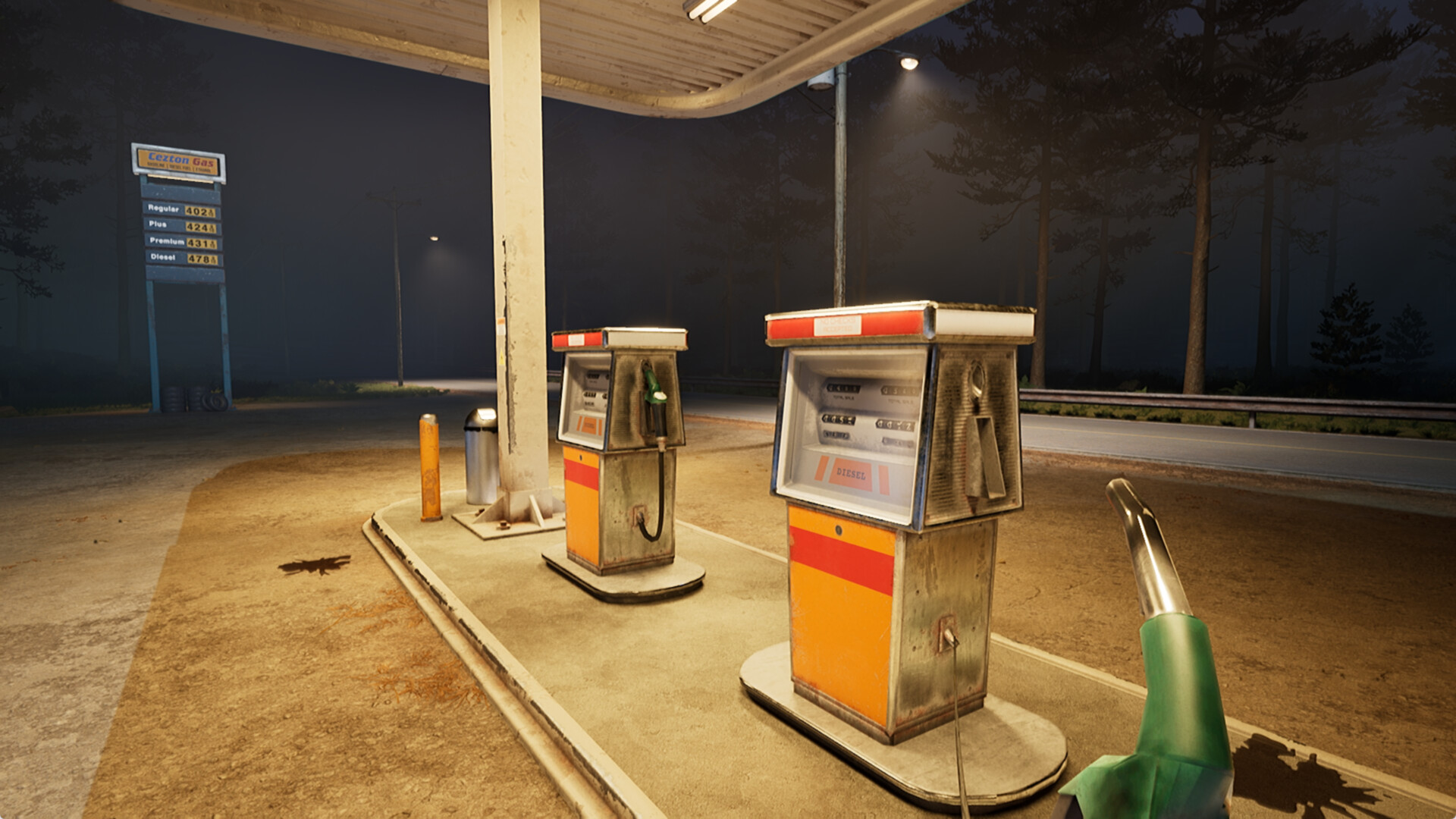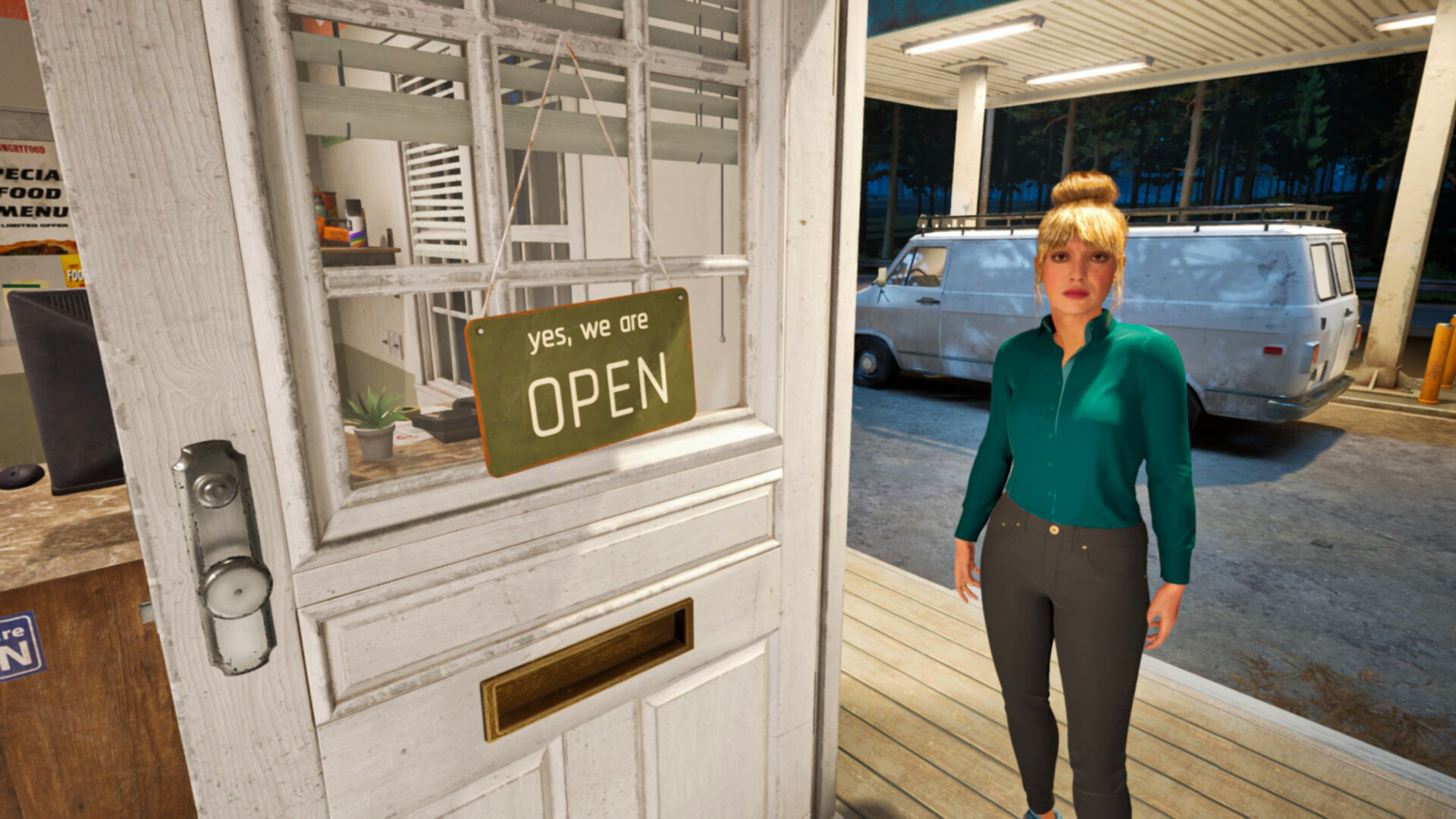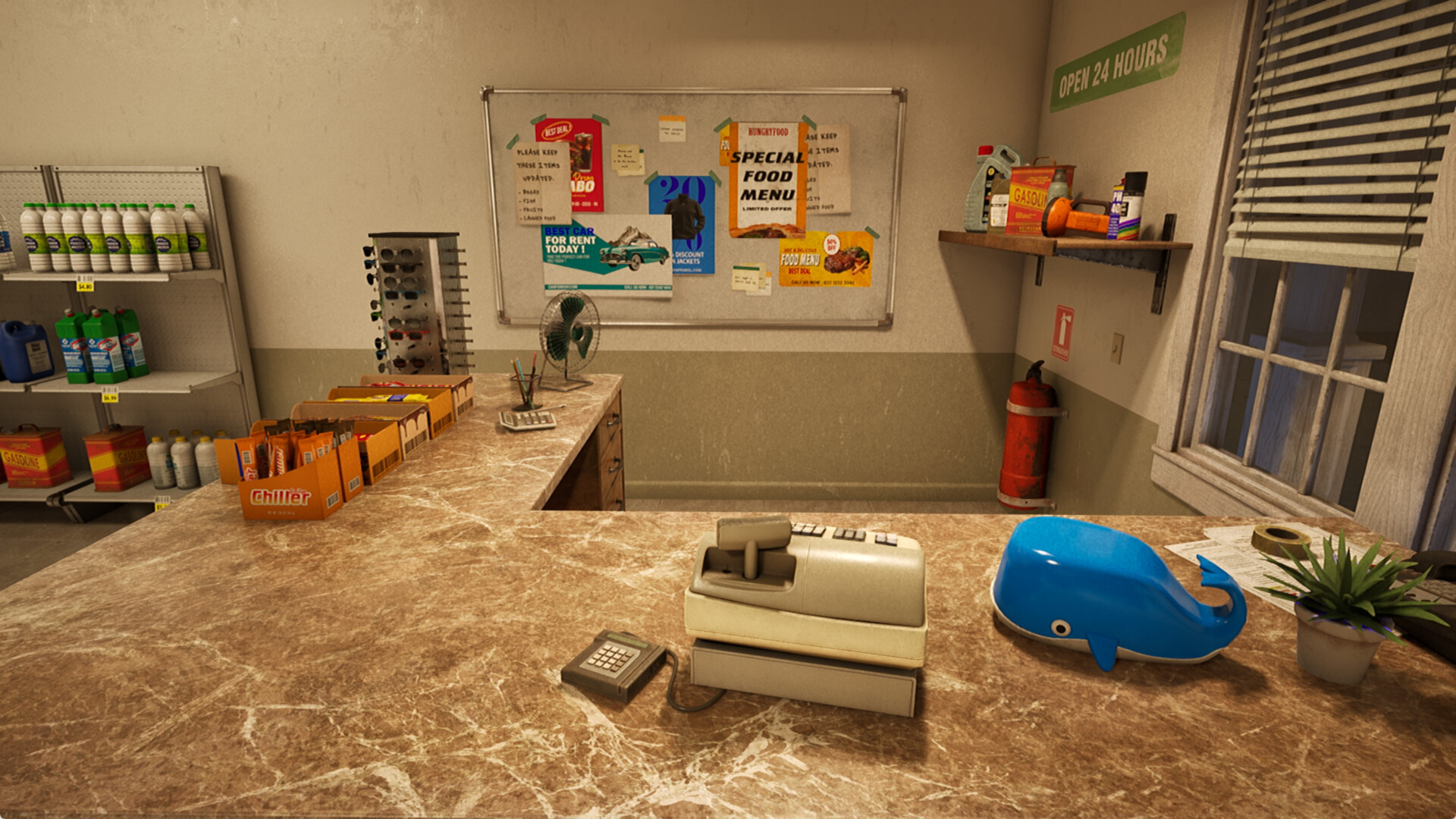
You’re the closer again, but the night feels thinner here; pump lights haloing the forecourt, a colder wind that makes every flicker more urgent. Before Exit: Gas Station takes the franchise’s tidy checklist and skews it toward the uncanny: routine closing chores become investigative beats threaded with subtle anomalies, slow‑burn dread, and narrative pivots that only reveal themselves after repeat runs. The game is a study in attention; to oil stains, register receipts, hesitant customers, and the tiny wrongnesses that quietly stack into something uncanny; and it rewards players who treat the shift like a slow, careful search for what doesn’t belong.
What the game is
• Premise: Take the lone night shift as a gas‑station closer; power down lights, lock the shop, clean spills, settle last‑minute customers, and inspect pumps and forecourt. The checklist is simple and merciless; miss a single condition and your boss’s audit ends your shift (and possibly your job). The gameplay turns routine chores into investigative beats where small oversights become narrative triggers.
• Scope and replay value: With 40+ story‑rich scenarios, four distinct endings, and six bonus episodes, the game is designed around repeat play. Each run unearths new fragments of story and meaning; only by revisiting the station multiple times will you see how scenarios interlock and how the true ending is teased out.
• Form and platform support: A hybrid of anomaly‑detection, light environmental puzzles, and roguelike permutation, Before Exit: Gas Station emphasizes observation, pattern recognition, and route planning over reflexes. The launch includes full controller support, Steam achievements, and 14 localized languages, making the experience accessible to a broad audience while keeping the core loop compact and repeatable.

Gameplay and structure
• Daily loop intensified: Each shift hands you a shifting task list; patrol the forecourt and shop, verify pump displays, secure dispensers, mop oil stains, and placate last‑minute customers who upend your rhythm. The boss’s audit is binary and unforgiving; a single overlooked item can end the night and send you back to start.
• Procedural variety with intent: The station reshuffles between days; scenarios rotate, anomalies relocate, and small events rearrange priorities so no two nights feel identical. Dozens of permutations push the game toward deduction and pattern recognition instead of reflexes, forcing you to refine routes and develop heuristics for efficient closes.
• Anomaly detection as puzzle design: Core gameplay is about spotting micro‑discrepancies; a pump meter that reads wrong, a neon panel that stutters, a receipt in the gutter; and interpreting them as signals rather than noise. Each detected anomaly functions both as a logic puzzle and a narrative breadcrumb, opening branches in storylines and unlocking new outcomes.
• Memory and routecraft: Success rewards mental maps and route optimization; remember where a stubborn light flickered, which pump behaved oddly, or which aisle tends to hide spills. Efficient closes emerge from learned patterns and deliberate scanning rather than speed.
• Emergent tension and reward: The best moments are small and human; a last‑second discovery that saves the shift, a near‑miss that rewrites your mental checklist, or a subtle clue that finally links across runs. Those micro‑victories are the engine that keeps you returning.

Presentation and atmosphere
• Dense moody visuals: Lighting and weather carry the game’s emotional weight: neon signage slices the night, pump lights throw haloed pools across slick asphalt, and interior lamps cast deep, utilitarian shadows. The station reads like a lived‑in diorama; scuffed linoleum, smeared oil, and half‑faced products are all legible at a glance; so every visual detail pulls double duty as mood and gameplay signal.
• Sound as tension and tool: Audio is both clue and atmosphere; low refrigerator hums, distant highway wind, the metallic click of a closing register, and the uncanny silence when music cuts out all act as functional guides. Rather than relying on jump scares, the soundscape ratchets suspicion; small creaks and off‑rhythms point your attention toward anomalies and reward careful listening.
• Pacing that respects repetition: Nightly runs are deliberately compact yet consequential: long enough to build tension and reveal secrets, short enough to encourage retries. That tight pacing makes each playthrough feel meaningful and keeps the loop addictive without overstaying its welcome.
• Visual and audio clarity: Design choices favor readable cues; contrast and placement ensure the wrongnesses you hunt are discoverable, and audio mixing highlights actionable sounds. This clarity is essential for an anomaly game; when the game points you at a problem, you should be able to confirm it quickly.
• Atmospheric payoff: The combined effect is a small, claustrophobic world that rewards patient inspection: light, sound, and texture work in concert to turn routine chores into uncanny discoveries.

Narrative and endings
• Layered storytelling: The campaign is built from shards; each scenario supplies discrete beats, character hints, and atmospheric details that rarely make sense in isolation. The game encourages pattern recognition; motifs, repeated dialogue, and recurring anomalies accumulate meaning across runs; so revelation is earned, not handed to you. That oblique approach makes discovery feel investigative: piecing together the station’s oddities becomes its own slow, satisfying narrative mechanic.
• Narrative scaffolding: Story fragments are deliberately distributed across scenarios, tied to specific anomaly types, customer encounters, and environmental clues. Successful anomaly resolutions often unlock new story threads, while seemingly mundane tasks sometimes trigger the richest revelations. The result is a networked narrative where plot progression depends on what you notice, when you notice it, and how thoroughly you follow up.
• Multiple outcomes and reward loops: With four distinct endings and six bonus episodes, the game rewards curiosity and methodical play. Endings are patterned rather than binary: different combinations of anomalies found, tasks completed, and episodes unlocked steer you toward alternative revelations. Bonus episodes act as keystones; solve them and previously opaque fragments snap into place.
• Replay purpose and player agency: Replaying isn’t filler; it’s the primary mode of discovery. Every run refines your mental map and reveals new connective tissue between scenarios. The structure privileges active interpretation, so players who keep notes, test hypotheses, and chase loose threads will be the ones who unlock the full, layered truth.
What’s new versus the franchise
• Stepping outside the shop: For the first time the franchise opens the forecourt: you can walk out to the pumps, inspect dispenser readouts, scrub oil stains from concrete, and confront late‑arriving customers under the neon glare. This expansion does more than add space; it broadens the anomaly palette, introduces exterior‑specific checks and rhythms, and forces you to plan routes that cross indoor and outdoor cues.
• More scenarios, more threads: The move to 40+ scenarios delivers significantly richer variety and a larger pool of narrative fragments to discover. That scale strengthens the game’s pattern‑recognition drive and gives each replay more chances to reveal new beats. A few players still report mid‑run repeats, but overall the expanded scenario set deepens replay value and makes long runs feel more like investigation than rote repetition.

Player feedback and polish notes
• Strengths players keep returning to: The game nails atmosphere; brooding neon, intimate sound design, and petit uncanny details coalesce into a richly textured mood. Players praise the anomaly puzzles for being clever and tactile; finding the wrongnesses feels like real detective work. Added mechanics like outside‑forecourt tasks and promotion‑style weeks give a satisfying sense of progression and reward curiosity.
• Pain points that crop up: Several players report hearing new or repeated scenarios mid‑playthrough, which can undercut the sense of steady discovery. Ambiguity over whether a task actually registered; especially for lights, pumps, or customer handoffs; creates frustrating “did I or didn’t I?” moments. These issues aren’t game‑breaking but they erode the trust the loop depends on.
• Concrete fixes that would help: Clearer daily task UI (explicit confirmation when an objective is completed), more deterministic state persistence for lights/doors/pump readings, and reduced scenario repetition would convert small annoyances into smooth, replayable systems. Even subtle feedback improvements; a distinct sound cue or an on‑screen tick for registered tasks; would dramatically cut down on needless retries.
• Achievements and stability: The game ships with controller support and a full achievement set, but players should expect the usual early‑patch housekeeping. Monitor patch notes for fixes to achievement tracking and state bugs; once those are tightened, the title’s replay incentives become far more reliable.

Who should play
• Play it if you like slow‑burn uncanny experiences, observational puzzles, and methodical repeat play to piece together a fractured narrative.
• Skip or wait if you prefer broad scope, action, or completely deterministic systems without occasional ambiguity in task registration.

Final Verdict
Before Exit: Gas Station refines the series’ deceptively simple loop into something quietly ambitious; a procedural, investigative sim that trades spectacle for sustained unease and satisfying micro‑puzzles. Its expanded play area, dozens of scenarios, and layered endings make replay feel purposeful: each night surfaces fresh clues, emergent moments, and narrative payoffs for players who treat the shift like a slow investigation. The game’s atmosphere; precise lighting, tactile audio, and readable visual signals; does most of the heavy lifting, turning everyday chores into tense, memorable beats. A handful of UX annoyances (ambiguous task registration, occasional scenario repeats) and polish gaps prevent it from reaching the heights its premise promises, but those are fixable. For anyone who loves anomaly detection, methodical sims, or slow‑burn storytelling, this is a textured, eerie little gem worth multiple nights at the pumps.
Watch and Wishlist
• Why wishlist: Keep an eye for patches that refine task feedback, reduce scenario repetition, and tighten state persistence; updates or DLC could expand bonus episodes or new locations.
• When to buy: Pick it up on launch if you’re curious about anomaly games and can tolerate some roughness; otherwise, wait for early patches or a sale.
Key Takeaways
• Ambitious expansion: Moves the checklist formula outdoors and multiplies scenarios, deepening the series’ mystery‑driven play.
• Anomaly core: Success depends on observation and deduction; small wrongnesses carry big narrative weight.
• Atmosphere first: Lighting and sound create sustained unease without relying on cheap scares.
• Replay required: Multiple runs are essential to unlock endings and piece the story together.
• Polish room: Clarified task feedback and fewer repeats would make the experience more satisfying across dozens of hours.
Game Information:
Developer & Publisher: Take IT Studio!
Platforms: Xbox Series X (reviewed), PC - Steam, PlayStation 5
Release Date: October 9, 2025
Score: 8.0 / 10
Before Exit: Gas Station is a reliably creepy, cleverly designed anomaly sim that rewards patience and careful play. With tighter UX and a few targeted fixes, it could easily score higher; as it stands, it’s a compelling recommendation for fans of methodical, replay‑driven experiences.